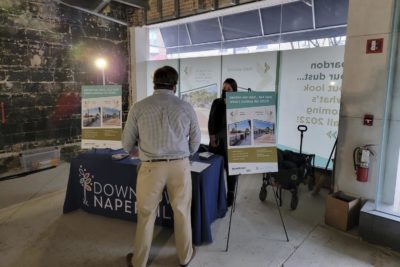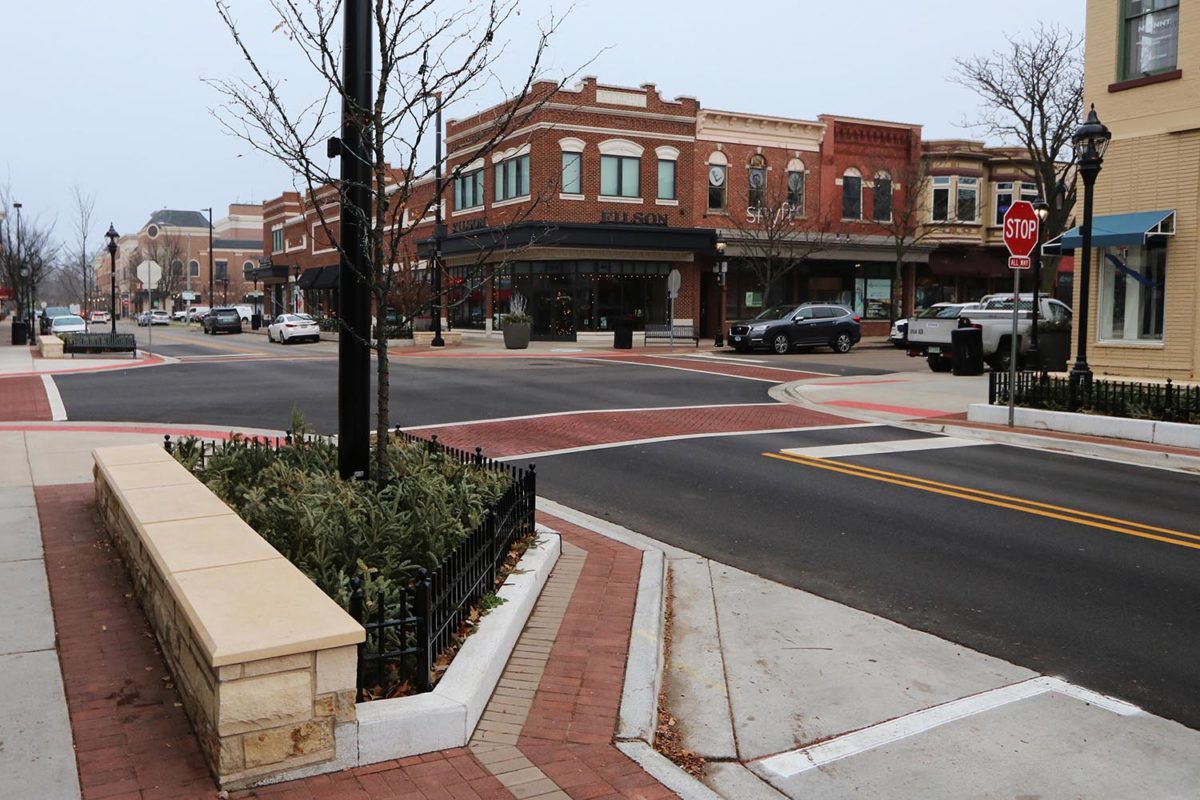
The City of Naperville has seen considerable growth and redevelopment. The area has been built with various standards and streetscape designs that had been incorporated at different times and generally in conjunction with previous City led projects. Civiltech was retained to provide Preliminary and Design Engineering services for proposed improvements to Main Street between Jackson Avenue and Jefferson Avenue, Jefferson Avenue from Main Street to Webster Street, portions of the east side of Webster Street south of Jefferson Avenue, and the north side of Jackson Avenue east and west of Main Street. The scope of the project included complete road reconstruction, streetscape amenities, utility replacement, and revised parking, with the overarching goal of improving pedestrian mobility and access. 
Civiltech also provided Construction Engineering services to administer the project. At the heart of the construction phase was pedestrian safety and maintaining access to downtown businesses during construction. Also of importance to the City was ensuring that the community understood the project and construction activities, felt invested in the process, and was excited about the project outcome.
Prioritizing Pedestrian Safety and Access to Businesses
With the core objectives of pedestrian safety and access to businesses within the work zone, the general contractor, RW Dunteman Construction, provided outstanding pedestrian focused traffic control in collaboration with Civiltech’s Resident Engineer, Art Politowicz, and the Downtown Naperville Alliance (DNA). The primary traffic control feature was closing the roads to vehicular traffic and keeping them open exclusively to pedestrians. 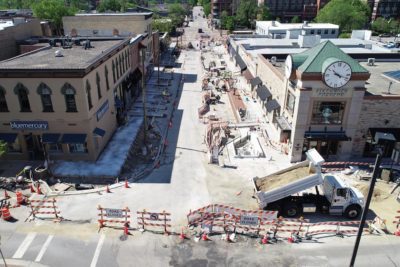
With the street closed to vehicular traffic, pedestrian barricades and temporary sidewalks could be relocated as needed for construction activities and staging. This approach also provided a safe work environment for the contractors. Barricaded areas were pedestrian friendly, and accessibility was ensured by using prefabricated aluminum ramps at storefront entries and grade changes.
Creative Community Relations
Community relations were critical. The City, contractor, and Civiltech needed to show that they understood the difficulties of construction while illustrating that the finished project would bring increased safety and accessibility, as well as improve the aesthetics and downtown vibrancy.
Naperville Alliance’s Executive Director collaborated with the construction team as a liaison with local businesses. She ensured that concerns or questions were addressed, and connected Civiltech’s R.E. with business owners if a construction activity needed to be explained. Also, the Executive Director would conduct email blasts to keep businesses abreast of critical construction and scheduling information. DNA led creative and fun messaging efforts with out-of-the-box ideas to keep the community informed, engaged, and excited for the project outcome.
Rendering the Finished Product 
With construction on the project about to get underway, the City had reached out to Civiltech’s digital rendering team to provide images of the finished project. Their initial goal was to display the images at a community meeting to build excitement for the project. Through a combination of CAD, 3DS Max, and Photoshop, the team turned photos of the existing conditions into exciting renderings that realistically depicted the beautiful finished streetscape.
Naperville’s graphic design team then incorporated the Civiltech renderings into an exhibit that they displayed in a centrally located empty storefront window within the project limits. With instructions to look left or look right, the public could easily visualize their new streetscape.
Other creative messaging techniques included large stickers on sidewalks and banners on barricades clearly indicating that businesses were open. A framed viewing stand was built in a strategic location to allow community members to watch the project progress from that viewpoint.
Keeping Businesses Open During Construction
Careful coordination with business owners regarding construction activities and schedule was critical. The project involved shut downs and hookups to water and sewer in individual businesses. This involved contractors needing access to basement and back areas of the retail spaces which required detailed communication and cooperative accommodation. 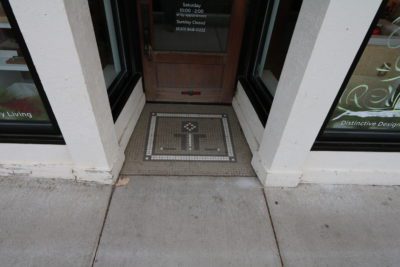
Also, the primary requirement of construction coordination was that the businesses remain fully open. Therefore, removing and replacing concrete in front of their storefronts and their doorways often had to be completed over night. The City allowed the contractor to work 24 hours a day to accommodate the businesses hours and to ensure that the project remained on schedule.
Sustainability and Resiliency
Environmental sustainability and resiliency components for long-term community benefit were factors in the streetscape design. The design included the installation of planters and trees. However, the goal was to include larger trees in a wider variety of species than is used in typical streetscapes. Thus, the streetscape included oversized planters with extensive soil. 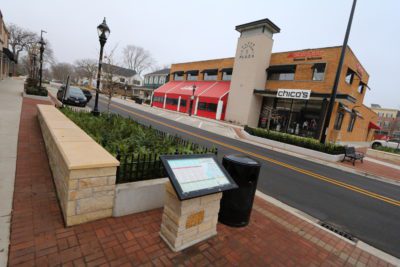
The larger planters created a challenge in that they competed for sidewalk space. This was mitigated by designing the planters to double as furnishings: 2 ft. high walls with limestone caps to sit on. Also, the quantity of parking was reduced creating extra space for the sidewalk and pedestrians.
Civiltech’s landscape architecture team specified a diverse selection of species to help protect the urban forest from a potential bug infestation that could destroy a specific species of tree. Also, the trees selected increase the tree canopy helping reduce a heat island effect and helping with storm water management. The planters have controlled irrigation and electrical access for seasonal flowers, greens, and decoration.
The project included an upgrade to a concrete base course in lieu of asphalt. This alternative material not only helped with maintaining the construction schedule, but provides a higher quality base course offering less maintenance and a longer life span. Also, the new decorative lighting utilizes LED lamps, which saves energy and requires less maintenance due to their long useful life.
Interesting Conditions Created by a 100 Year Old Downtown
The City of Naperville is over 100 years old. As such, a myriad of unexpected discoveries were unearthed during excavation. Many old utilities were discovered and the team had to determine what was live, what should be removed, and what could be abandoned.
Many areas of non-special waste were exposed and the project involved extensive underground cleanup. The project team included an environmental consultant to test materials and make sure that anything hazardous was removed safely.
One area of contaminated soil was discovered that was infused with old dry cleaning fluid. This soil had to be removed, sealed in containers, and shipped to a specialized recycling facility in Michigan. Civiltech’s R.E. ensured that the team was quick to deal with this and other non-special waste conditions, handle them appropriately, and allow construction to move forward with the problem remedied.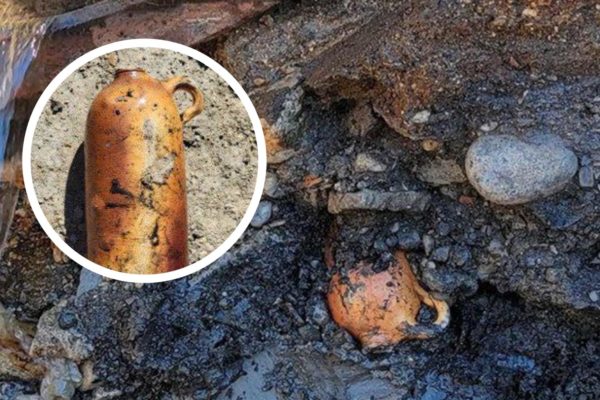
One interesting discovery was unearthed by Civiltech’s R.E. while working with the contractor to excavate at a location needed to replace storm sewer. The existing clay pipe, estimated to be about 100-years old was encased in a brick structure. That brick housing was then within another old limestone structure. The limestone indicated that it could have been part of an old bridge that had later been used as a conduit to run the existing water main through.
During this excavation, the R.E. noticed what he thought was an old teapot down in the dirt. He climbed down into the hole to pull it out. With the object longer than first realized, he used a shovel and extricated an elongated vessel. With some research, it was discovered that the object was a mineral water jug most likely made in the 1800s in Germany, which would align with the approximate age of the limestone structure adjacent to it. A number engraved on the vessel designates the spring from which it originated. The City of Naperville and Naperville Settlement are working together to determine an appropriate new home for the vintage vessel.
Designing for the Community
During design, the Civiltech team listened to the community to understand the objectives and interests of the wide variety of stakeholders. Then, the team worked extensively to select design alternatives to meet those objectives and interests on which the public was invited to weigh in. Design feature considerations included not only aesthetics, but maintenance and life span of materials used. As such, the design parameters of this project are now the standard for additional forthcoming streetscape improvements in the City.
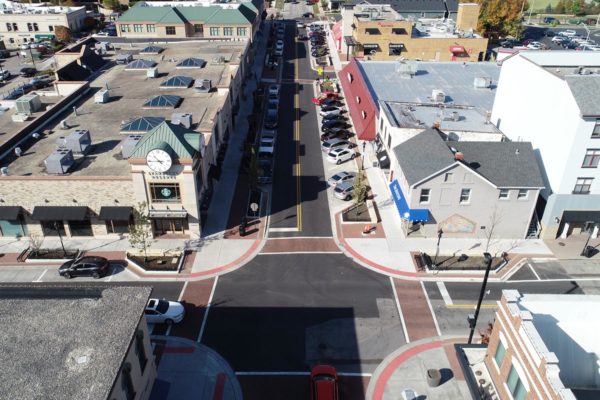
Civiltech was honored to assist the City in the improvement and preservation of their downtown with its emphasis on pedestrian convenience, safety, and accessibility. Sustainable downtowns understand their community’s needs and maintain the resources to adapt when necessary. They rely on community input, outside help, and a clear path to the future. A broad coalition of community stakeholders reinforces community driven imperatives. The City of Naperville has shown their commitment to a sustainable community through this infrastructure and streetscape improvement.

